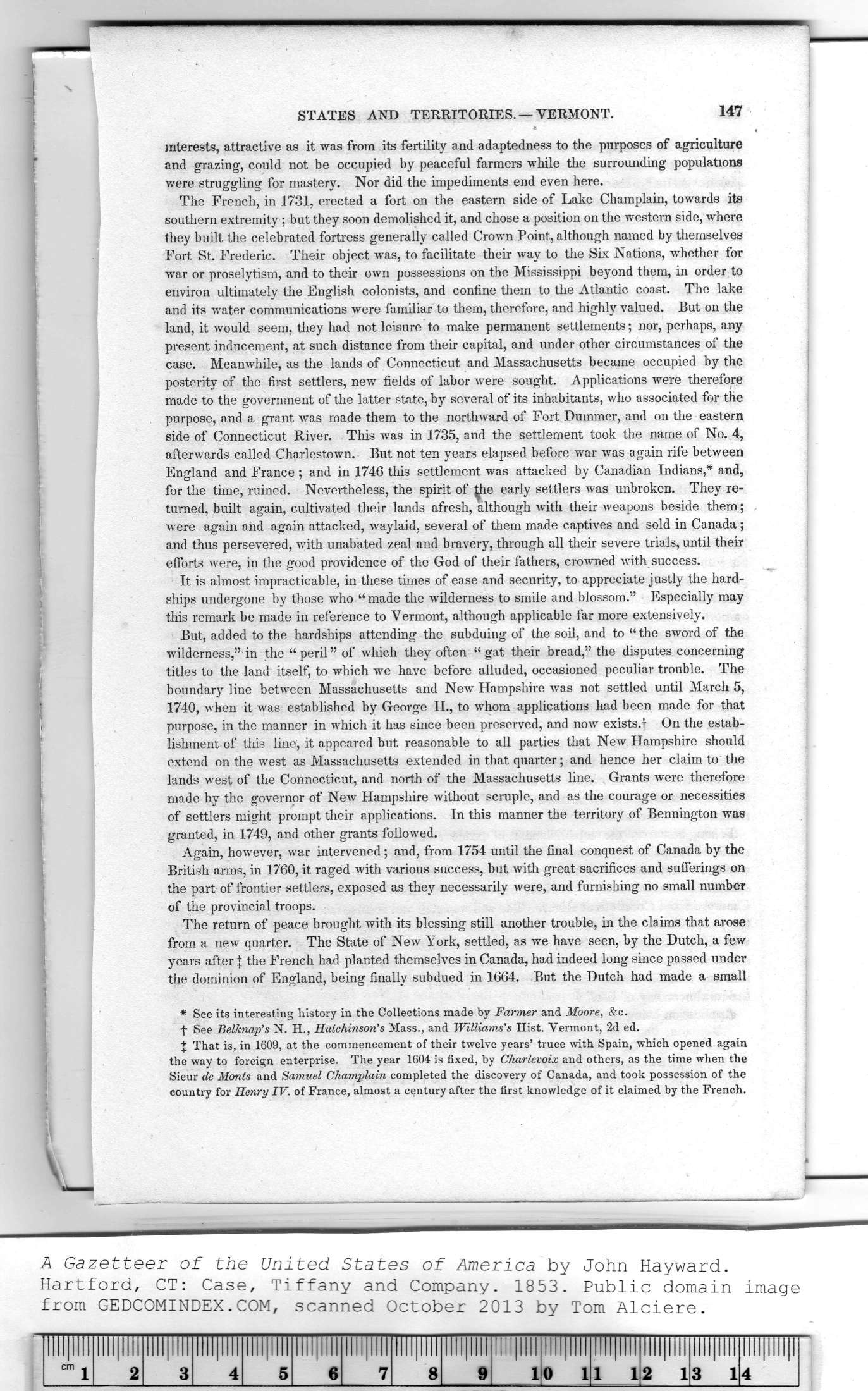|
|
Note: Ctrl and + increases the font size of the text below, Ctrl and - decreases it, and Ctrl and 0 resets it to default size.
STATES AND TERRITORIES. — VERMONT. 147
interests, attractive as it was from its fertility and adaptedness to the purposes of agriculture
and grazing, could not be occupied by peaceful farmers while the surrounding populations
were struggling for mastery. Nor did the impediments end even here.
The French, in 1731, erected a fort on the eastern side of Lake Champlain, towards its
southern extremity; but they soon demolished it, and chose a position on the western side, where
they built the celebrated fortress generally called Crown Point, although named by themselves
Fort St. Frederic. Their object was, to facilitate their way to the Six Nations, whether for
war or proselytism, and to their own possessions on the Mississippi beyond them, in order to
environ ultimately the English colonists, and confine them to the Atlantic coast. The lake
and its water communications were familiar to them, therefore, and highly valued. But on the
land, it would seem, they had not leisure to make permanent settlements; nor, perhaps, any
present inducement, at such distance from their capital, and under other circumstances of the
case. Meanwhile, as the lands of Connecticut and Massachusetts became occupied by the
posterity of the first settlers, new fields of labor were sought. Applications were therefore
made to the government of the latter state, by several of its inhabitants, who associated for the
purpose, and a grant was made them to the northward of Fort Dummer, and on the eastern
side of Connecticut River. This was in 1735, and the settlement took the name of No. 4,
afterwards called Charlestown. But not ten years elapsed before war was again rife between
England and France ; and in 1746 this settlement was attacked by Canadian Indians,* and,
for the time, ruined. Nevertheless, the spirit of j^he early settlers was unbroken. They re-
turned, built again, cultivated their lands afresh, although with their weapons beside them;
were again and again attacked, waylaid, several of them made captives and sold in Canada;
and thus persevered, with unabated zeal and bravery, through all their severe trials, until their
efforts were, in the good providence of the God of their fathers, crowned with success.
It is almost impracticable, in these times of ease and security, to appreciate justly the hard-
ships undergone by those who “ made the wilderness to smile and blossom." Especially may
this remark be made in reference to Vermont, although applicable far more extensively.
But, added to the hardships attending the subduing of the soil, and to “ the sword of the
wilderness," in the “peril" of which they often “gat their bread," the disputes concerning
titles to the land itself, to which we have before alluded, occasioned peculiar trouble. The
boundary line between Massachusetts and New Hampshire was not settled until March 5,
1740, when it was established by George II., to whom applications had been made for that
purpose, in the manner in which it has since been preserved, and now exists.f On the estab-
lishment of this line, it appeared but reasonable to all parties that New Hampshire should
extend on the west as Massachusetts extended in that quarter; and hence her claim to the
lands west of the Connecticut, and north of the Massachusetts line. Grants were therefore
made by the governor of New Hampshire without scruple, and as the courage or necessities
of settlers might prompt their applications. In this manner the territory of Bennington was
granted, in 1749, and other grants followed.
Again, however, war intervened; and, from 1754 until the final conquest of Canada by the
British arms, in 1760, it raged with various success, but with great sacrifices and sufferings on
the part of frontier settlers, exposed as they necessarily were, and furnishing no small number
of the provincial troops.
The return of peace brought with its blessing still another trouble, in the claims that arose
from a new quarter. The State of New York, settled, as we have seen, by the Dutch, a few
years after \ the French had planted themselves in Canada, had indeed long since passed under
the dominion of England, being finally subdued in 1664. But the Dutch had made a small
* See its interesting history in the Collections made by Farmer and Moore, &c.
f See Belknap's N. H., Hutchinson's Mass., and Williams's Hist. Vermont, 2d ed.
J That is, in 1609, at the commencement of their twelve years' truce with Spain, which opened again
the way to foreign enterprise. The year 1604 is fixed, by Charlevoix and others, as the time when the
Sieur de Monts and Samuel Champlain completed the discovery of Canada, and took possession of the
country for Henry IV. of France, almost a century after the first knowledge of it claimed by the French.
|
Illllllll |
Illllllll |
Illllllll |
Illllllll |
Illllllll |
Illllllll |
llll|llll |
Illllllll |
llll|llll |
Illllllll |
Illllllll |
Illllllll |
Illllllll |
Illllllll |
|
|
2 |
3 |
4 |
5 |
6 |
7 |
8 |
9 |
1 |
0 1 |
1 1 |
2 1 |
3 1 |
|
